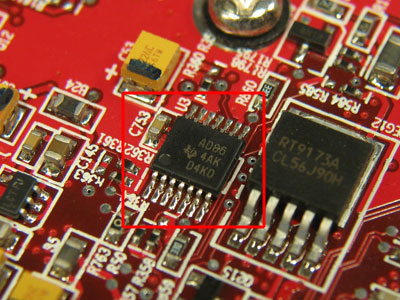Guide to Video BIOS flashing |
|
Introduction

The video is BIOS is a small piece of code (typically <64 KB), which is stored inside a small chip on your video card. When the VGA card receives power, the BIOS is loaded into system memory and immediately executed by the CPU.
On startup, the BIOS initializes the video card:
- Initialize the GPU
- Detect number of memory chips, chip size, access mode
- Enable memory access and set proper timings
- Detect if external devices (analog VGA, DVI, TV-out) are connected and enable them
- Set core and memory clock
- Enable power management
- Set fan speed (if supported by the board)
Once you boot into Windows, the display driver takes over all video functions and the BIOS is no longer used. However, it remains accessible for execution. Actually, manufacturers like ATI added a handful of functions which can be invoked from within Windows, for example to change power management settings on a mobile GPU.
Why flash the BIOS?
Originally, the video BIOS was stored in a ROM (Read Only Memory) and could not be replaced. Nowadays it is located in a flash memory chip (that's why it's called 'flashing').The reason for this move was that like every other piece of software, the BIOS had programming errors, or an issue was detected in the hardware for which a workaround had to be found. So the manufacturers just gave out an updated BIOS to a customer to fix the issue.
The more interesting use is to mod cards. For example, on the X800 Pro VIVO you can unlock additional pipelines by changing the BIOS. How so? Inside the BIOS is a small block of information which tells the GPU how many pipelines it should run at. If you replace the original BIOS with a BIOS which tells the GPU "16 Pipelines!" .. well, then you are running 16 pipelines.
Another good use is to change the default clocks of the card. As you remember from above, the BIOS sets the core and memory clock. On the last page of this article we will cover the different BIOS editors and their use.
Sometimes a new BIOS increases performance as well. However, my personal experience is that this difference is rather small. However, if you do upgrade your video BIOS for this reason, make sure you run benchmarks before and after.
Apr 26th, 2024 12:22 EDT
change timezone
Latest GPU Drivers
New Forum Posts
- checkup (1)
- Help me to OC my 5700X (10)
- XFX RX470 8GB no video and error 43 (28)
- The TPU UK Clubhouse (24788)
- Secure boot already open help (9)
- im new to throttelstop and i think i messed it up by copying others any hints would be very much aprreciated (4)
- Cs2 Freezing in Rx 580 (5)
- Ghost of Tsushima PC Port !!!! (15)
- The Official Linux/Unix Desktop Screenshots Megathread (699)
- Red Dead Redemption using emu (4)
Popular Reviews
- HYTE THICC Q60 240 mm AIO Review
- MOONDROP x Crinacle DUSK In-Ear Monitors Review - The Last 5%
- Alienware Pro Wireless Gaming Keyboard Review
- Upcoming Hardware Launches 2023 (Updated Feb 2024)
- Thermalright Phantom Spirit 120 EVO Review
- FiiO K19 Desktop DAC/Headphone Amplifier Review
- ASUS Radeon RX 7900 GRE TUF OC Review
- RTX 4090 & 53 Games: Ryzen 7 5800X vs Ryzen 7 5800X3D Review
- NVIDIA RTX 4090: 450 W vs 600 W 12VHPWR - Is there any notable performance difference?
- Sapphire Radeon RX 7900 GRE Pulse Review
Controversial News Posts
- Windows 11 Now Officially Adware as Microsoft Embeds Ads in the Start Menu (127)
- Sony PlayStation 5 Pro Specifications Confirmed, Console Arrives Before Holidays (117)
- NVIDIA Points Intel Raptor Lake CPU Users to Get Help from Intel Amid System Instability Issues (106)
- AMD "Strix Halo" Zen 5 Mobile Processor Pictured: Chiplet-based, Uses 256-bit LPDDR5X (101)
- US Government Wants Nuclear Plants to Offload AI Data Center Expansion (98)
- AMD's RDNA 4 GPUs Could Stick with 18 Gbps GDDR6 Memory (92)
- Developers of Outpost Infinity Siege Recommend Underclocking i9-13900K and i9-14900K for Stability on Machines with RTX 4090 (85)
- Windows 10 Security Updates to Cost $61 After 2025, $427 by 2028 (84)